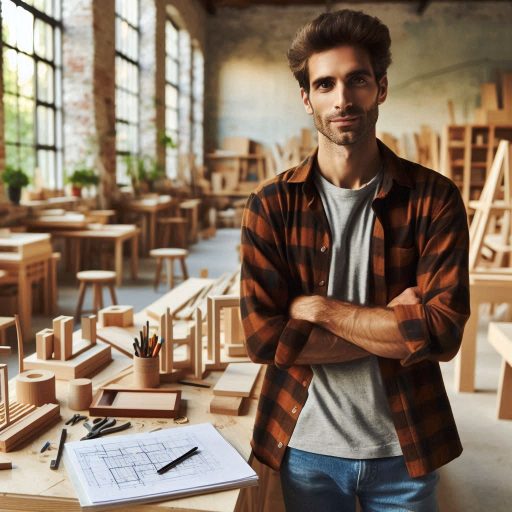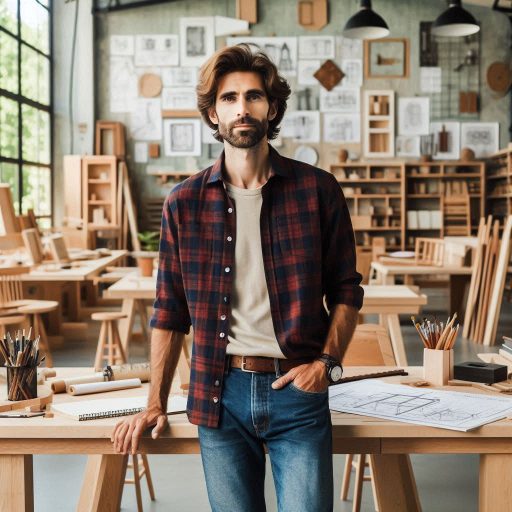Introduction
Balancing art and function in furniture design means merging beauty with utility.
Designers strive to create pieces that are visually appealing yet practical.
This balance is essential in ensuring that furniture serves its purpose while enhancing interior spaces.
Aesthetic appeal draws attention.
Beautiful furniture can transform a room’s atmosphere.
It invites admiration and contributes to the overall design theme.
However, aesthetics alone do not guarantee success.
If a piece lacks functionality, it risks becoming obsolete.
A chair may look stunning but fails if it is uncomfortable.
Thus, designers face the challenge of meeting both needs.
Functionality defines a piece‘s usability.
Furniture must fulfill its intended role effectively.
A dining table should accommodate meals and gatherings.
A sofa should provide comfort for relaxation.
Without functionality, even the most artistic designs lose their value.
This highlights the need for a thoughtful approach to design.
Finding harmony between aesthetics and practicality is crucial.
It requires a deep understanding of both elements.
Designers often start with a concept that marries beauty and utility.
They consider how each design choice affects overall function.
For example, using elegant curves in a chair design can enhance its visual appeal.
At the same time, these curves must ensure comfort and support.
Understanding the Role of Art in Furniture Design
Art plays a crucial role in furniture design.
Designers draw inspiration from various art forms, integrating them into their creations.
This fusion enhances the visual appeal of furniture.
Each piece becomes not just functional but also a work of art.
Discuss How Art Influences Design Choices
Art influences design choices significantly.
Designers use artistic principles to create harmony and balance.
They consider elements like proportion, scale, and rhythm when crafting furniture.
These principles guide designers in achieving aesthetically pleasing results.
Importance of Creativity and Innovation in Creating Unique Pieces
Creativity and innovation drive unique furniture pieces.
Designers push boundaries, experimenting with unconventional materials and forms.
This willingness to take risks often leads to groundbreaking designs.
Innovative furniture can transform spaces and redefine functionality.
Use of Artistic Elements Such as Color, Shape, and Texture to Enhance Aesthetics
Artistic elements, such as color, shape, and texture, enhance aesthetics.
Color evokes emotions and sets the mood in a room.
Designers strategically choose color palettes to complement existing decor.
Bold colors can create a statement, while subtle hues promote tranquility.
Shape also plays a vital role in furniture design.
Unique shapes can captivate attention and provoke thought.
Curved lines often convey softness, while sharp angles suggest modernity.
Designers blend shapes to create pieces that resonate with users.
Texture adds depth and interest to furniture.
Designers use various materials to achieve desired textures.
Smooth finishes invite touch, while rough surfaces add character.
This tactile experience engages users and enhances the overall design.
Art enables designers to tell stories through furniture.
Each piece reflects cultural influences, personal experiences, and artistic movements.
Designers often draw from history, integrating traditional motifs with contemporary styles.
This storytelling aspect connects users to the furniture on a deeper level.
Moreover, the interplay between art and functionality cannot be overlooked.
Furniture must serve a purpose while also pleasing the eye.
Successful designers balance these two aspects seamlessly.
They create pieces that are both beautiful and practical, meeting the needs of users.
Art elevates furniture design beyond mere utility.
It transforms ordinary objects into extraordinary experiences.
When designers embrace art, they craft pieces that inspire and delight.
This approach fosters a deeper appreciation for furniture as an art form.
In addition, understanding the role of art in furniture design enriches the creative process.
Designers who embrace artistic principles create unique, innovative pieces.
By considering color, shape, and texture, they enhance the aesthetic experience.
Ultimately, art and function coexist harmoniously in the world of furniture design.
Read: Top Skills Needed for Art Educators and Instructors
Considering functionality in furniture design
When it comes to furniture design, finding the perfect balance between art and function is essential.
A piece of furniture should not only be visually appealing but also serve its intended purpose effectively.
This delicate balance is what sets great furniture apart from the rest.
Considering functionality in furniture design
One of the key factors to consider in furniture design is usability and comfort.
Furniture is meant to be used daily, so it should be designed with the user’s needs in mind.
Comfortable seating, ample storage space, and easy-to-use mechanisms are all aspects that contribute to the functionality of a piece of furniture.
Ergonomic principles play a crucial role in furniture design.
The design of furniture should take into account the human body’s natural movements and postures to ensure maximum comfort and efficiency.
By incorporating ergonomic principles, designers can create furniture that not only looks good but also promotes the well-being of the user.
Striking a balance between aesthetics and functionality
Creating furniture that is both beautiful and useful requires a careful balance between aesthetics and functionality.
A visually appealing design should not compromise the practicality and usability of the furniture.
It is essential to consider how the design elements impact the overall functionality of the piece.
One way to achieve this balance is by prioritizing function over form.
Designers should first determine the primary purpose of the furniture piece and then work on enhancing its aesthetic appeal.
By focusing on how the furniture will be used, designers can ensure that the final product meets the needs of the user while still being visually pleasing.
Another approach to balancing art and function in furniture design is to incorporate multi-functional elements.
Furniture that serves more than one purpose not only maximizes space but also adds a unique design element to the room.
For example, a coffee table that doubles as a storage unit or a sofa bed that provides extra sleeping space can offer both functionality and aesthetic appeal.
It is also important to consider the materials and construction techniques used in furniture design.
High-quality materials and sturdy construction not only enhance the durability of the furniture but also contribute to its overall functionality.
Choosing materials that are both visually appealing and practical is key to creating furniture that is both beautiful and long-lasting.
In a nutshell, balancing art and function in furniture design is a complex yet rewarding process.
By considering usability, comfort, ergonomic principles, and the relationship between aesthetics and functionality, designers can create furniture that not only looks good but also serves its purpose effectively.
Striking the perfect balance between art and function is what sets exceptional furniture pieces apart from the ordinary.
Read: Collaborating with Other Creative Roles
Examples of Furniture Designs That Successfully Balance Art and Function
Contemporary Pieces That Blend Art and Functionality Seamlessly
Contemporary furniture design increasingly emphasizes the balance between art and function.
Designers craft pieces that serve practical purposes while also acting as striking art forms.
One exemplary piece is the Tansu Bench by Gensler.
This bench features an intricate, sculptural design that draws inspiration from Japanese tansu cabinets.
Its artistic silhouette captures attention, yet it remains a comfortable seating option.
Another impressive example is the Sofa by Patricia Urquiola.
This piece combines sleek lines with vibrant colors and textures.
Urquiola‘s design integrates artistic elements like asymmetrical shapes, creating visual interest without sacrificing comfort.
Users enjoy the inviting feel of the sofa, making it both functional and beautiful.
How Designers Have Incorporated Artistic Elements Without Compromising Usability
The Sculptural Coffee Table by Maya Lin perfectly illustrates this balance.
Made from polished aluminum, its flowing form resembles a natural landscape.
This artistic touch elevates the table‘s aesthetic appeal while providing ample surface area for drinks and decor.
Its unique design sparks conversations, making it a centerpiece in any room.
The Eero Saarinen Tulip Table is another iconic piece that exemplifies this harmony.
The table‘s smooth, organic shape creates an elegant silhouette.
Its single pedestal base offers stability and maximizes legroom, ensuring usability.
This design reflects Saarinen’s vision of eliminating the clutter of legs, merging functionality with a stunning visual presence.
The Wishbone Chair by Hans J. Wegner further demonstrates the integration of art and usability.
Its graceful curves and woven seat create a sculptural effect.
This chair invites comfort and support, making it an ideal choice for dining or relaxation.
Wegner‘s design showcases craftsmanship while meeting practical needs.
Designers also explore innovative materials to enhance both aesthetic and functional qualities.
For instance, Neri&Hu‘s Yuan Chair combines wood and metal, creating a striking contrast.
The use of mixed materials highlights the craftsmanship while ensuring durability and comfort.
This piece showcases how materials can enhance both visual appeal and usability.
The Impact of Balanced Design on the Overall Aesthetic Appeal of a Space
Balancing art and function in furniture design significantly impacts the overall aesthetic of a space.
When furniture serves as both art and utility, it transforms interiors into cohesive environments.
Each piece contributes to a room‘s narrative, creating a harmonious blend of style and purpose.
By choosing designs that prioritize this balance, homeowners elevate their spaces, making them not only livable but also visually stunning.
In general, contemporary furniture successfully merges artistic expression with practical function.
Designers continue to innovate, ensuring that beauty and usability coexist in every piece.
This balance enriches the user experience, enhancing the overall appeal of any space.
Challenges in Balancing Art and Function in Furniture Design
Balancing art and function in furniture design presents unique challenges for designers.
Many designers struggle to integrate aesthetic appeal with practical utility.
This challenge often arises from the varying expectations of clients and the demands of specific environments.
Designers must navigate these competing priorities while maintaining their creative vision.
Address Common Issues Faced by Designers in Finding the Right Balance
One common issue is the conflicting desires for beauty and practicality.
Clients often seek visually striking pieces that also serve everyday purposes.
For instance, a client may want a stunning coffee table that also provides ample storage.
This requires designers to think creatively about how to incorporate functional elements without sacrificing artistic integrity.
How Design Constraints and Client Preferences Can Impact the Balance
Design constraints further complicate this balance.
Designers frequently work within limited budgets, materials, or manufacturing processes.
These limitations can restrict creative options, forcing designers to compromise on either form or function.
Additionally, space considerations can impact design choices.
A large, ornate piece may look stunning but may overwhelm a small room.
Client preferences can also influence the balance between art and function.
Some clients prioritize style, while others focus on practicality.
A designer may encounter a situation where a client insists on a highly decorative design, ignoring essential usability factors.
This discrepancy can lead to frustration for designers trying to deliver both beauty and functionality.
Strategies for Overcoming Challenges and Creating Harmonious Designs
To overcome these challenges, designers can employ several effective strategies.
First, open communication with clients is crucial.
Discussing expectations and preferences upfront helps establish a clear vision.
Designers can present sketches or prototypes to ensure alignment with client goals.
This collaborative approach fosters mutual understanding and reduces the likelihood of misaligned expectations.
Another strategy involves embracing a modular design approach.
Modular furniture allows for flexibility and adaptability, catering to both aesthetic desires and functional needs.
Designers can create pieces that can be reconfigured or expanded, offering versatility without compromising style.
This adaptability often appeals to clients who desire both beauty and practicality.
Additionally, exploring innovative materials can help designers achieve a harmonious balance.
Lightweight composites or sustainable materials can provide functionality while allowing for creative expression.
By selecting materials that align with the design vision, designers can create pieces that are both stunning and useful.
Finally, ongoing education and inspiration are vital for designers.
Keeping up with industry trends, attending workshops, and studying successful designs can spark new ideas.
By learning from others and experimenting with their work, designers can discover fresh solutions to the art-function balance.
Basically, balancing art and function in furniture design presents challenges that require thoughtful strategies.
By addressing client preferences, understanding design constraints, and employing innovative approaches.
Designers can create harmonious pieces that satisfy both aesthetic and practical needs.
Read: Historic Costume Design Inspirations

Trends in furniture design that focus on balancing art and function
In today‘s furniture design landscape, balancing art and function has become essential.
Designers increasingly prioritize aesthetics while ensuring that pieces serve practical purposes.
This trend reflects a broader cultural shift toward valuing both beauty and usability in our living spaces.
Current Trends in Furniture Design That Prioritize Both Aesthetics and Functionality
Current trends highlight the integration of organic shapes and materials.
Curved forms create a sense of softness and invite interaction.
These designs often evoke a feeling of comfort while maintaining a striking visual appeal.
For instance, furniture pieces with flowing lines can become focal points in a room, enhancing the overall atmosphere.
Transform Your Career Today
Unlock a personalized career strategy that drives real results. Get tailored advice and a roadmap designed just for you.
Start NowHow Sustainability and Eco-Conscious Design Play a Role in Balancing Art and Function
Sustainability plays a crucial role in modern design trends.
Eco-conscious designers focus on materials that minimize environmental impact.
They choose reclaimed wood, recycled metals, and sustainable fabrics to create beautiful yet functional pieces.
By using these materials, designers showcase their commitment to the planet without sacrificing style.
Importance of Adaptability and Versatility in Modern Furniture Designs
Moreover, many contemporary designs feature modularity and adaptability.
Furniture that can be easily rearranged or transformed caters to the evolving needs of users.
For example, a sectional sofa can be reconfigured to suit different spaces and occasions.
This flexibility enhances the utility of the furniture, making it both artistic and practical.
Another trend emphasizes multifunctionality.
Designers create pieces that serve multiple purposes, such as coffee tables with hidden storage or sofas that convert into beds.
These innovative designs reflect a growing need for efficiency in smaller living spaces.
By incorporating multiple functions, designers ensure that their creations remain relevant and useful.
The importance of aesthetics cannot be overstated.
Beautiful designs create an emotional connection with users.
A well-crafted piece can evoke joy and inspire creativity in a space.
Designers today understand that artful details, such as intricate patterns or bold colors, enhance the overall appeal of their furniture.
Moreover, the rise of biophilic design influences the trend toward balancing art and function.
This approach integrates natural elements into interiors, promoting well-being.
Designers incorporate plant-inspired motifs or natural materials to create a serene atmosphere.
This connection to nature enriches the aesthetic experience while enhancing functionality.
In summary, trends in furniture design increasingly prioritize the balance between art and function.
Sustainability, adaptability, and multifunctionality are key components of this balance.
As designers continue to innovate, they will create pieces that inspire and meet the practical needs of everyday life.
This evolution ensures that furniture remains not only a necessity but also a source of beauty in our homes.
Read: Freelance vs. In-House Costume Design Jobs
Tips for Designers to Successfully Balance Art and Function in Furniture Design
Balancing art and function in furniture design requires careful consideration. Here are practical tips to achieve this harmony.
Practical Advice for Incorporating Artistic Elements While Considering Usability
First, start by understanding your audience.
Identify their needs and preferences.
Consider how they will use the furniture.
This knowledge helps you prioritize functionality while allowing for artistic expression.
Next, experiment with materials.
Choose options that enhance both aesthetics and usability.
For instance, explore wood, metal, or sustainable materials.
Each material offers unique properties that can elevate your design while ensuring durability.
Incorporate versatile features into your designs.
For example, consider multifunctional pieces that serve several purposes.
A coffee table that converts into a desk combines practicality with style.
This approach maximizes space while maintaining artistic flair.
Emphasize the importance of scale and proportion.
Ensure that your furniture fits the intended space and complements its surroundings.
Oversized pieces can overwhelm a room, while tiny items may go unnoticed.
Striking the right balance enhances both art and function.
The Importance of Experimentation and Pushing Creative Boundaries
Experimentation plays a crucial role in the design process.
Don’t be afraid to push creative boundaries.
Try unconventional shapes or unexpected color combinations.
This willingness to innovate can lead to unique designs that stand out.
Involve users in your design process.
Gather feedback through surveys or focus groups.
Understanding user experiences helps refine your designs.
This collaboration ensures that your artistic elements align with functional needs.
Encourage Designers to Collaborate with Experts in Different Fields to Enhance Both Art and Function in Their Designs
Consider collaborating with experts from various fields.
Engage engineers, ergonomists, or even artists.
Their insights can elevate your designs and provide fresh perspectives.
This cross-disciplinary approach enriches both the artistic and functional aspects of your work.
Keep usability at the forefront of your designs.
Test prototypes with real users to identify potential issues.
This hands-on approach allows you to make necessary adjustments.
It ensures that your final product meets both aesthetic and practical criteria.
Incorporate sustainable practices into your design process.
Using eco-friendly materials adds an artistic dimension.
This approach appeals to environmentally conscious consumers and enhances your brand‘s value.
Finally, stay open to feedback and continuous learning.
Attend workshops or conferences to expand your skills.
Learning from others in the field fosters growth and innovation.
Balancing art and function in furniture design requires intention and creativity.
By following these tips, you can create pieces that are both beautiful and practical.
Embrace experimentation, collaboration, and user feedback to refine your designs.
The result will be furniture that truly enhances any space.
Discover More: Sustainable Practices in Furniture Design
Conclusion
As we conclude, it is essential to remember the significance of achieving a harmonious balance between art and function in furniture design.
It is not enough for furniture to be aesthetically pleasing; it must also serve a practical purpose in people’s lives.
By striking this balance, designers can create pieces that not only look good but also enhance the functionality of a space.
Recap of Finding a Balance
Finding a balance between art and function in furniture design ensures that pieces are both visually appealing and practical.
It allows for furniture to serve its intended purpose while adding beauty and style to a space.
Value of Creating Functional Furniture
The value of creating furniture that is not only visually appealing but also functional cannot be understated.
Functional furniture enhances the daily lives of users by providing them with comfort, convenience, and efficiency.
It transforms a space into a place that meets both aesthetic and practical needs.
Encouragement for Designers
We encourage designers to continue exploring innovative ways to blend art and function in their work.
By pushing the boundaries of traditional furniture design, they can create pieces that are both artistic and highly functional.
This constant exploration and experimentation are what drive progress in the world of furniture design and elevate the industry to new heights.
[E-Books for Sale]
The Big Book of 500 High-Paying Jobs in America: Unlock Your Earning Potential
$19.99 • 500 High-Paying Jobs • 330 pages
Explore 500 high-paying jobs in America and learn how to boost your career, earn more, and achieve success!
See All 500 High-Paying Jobs of this E-Book
1001 Professions Without a Degree: High-Paying American Jobs You Can Start Now
$19.99 • 1001 Professions Without a Degree • 174 pages
Discover 1001 high-paying jobs without a degree! Unlock career tips, skills, and success strategies for just $19.99!




